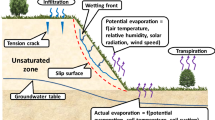Abstract
Over the last decades the Karsten tube has been used as a versatile testing device to measure the water absorption of porous walls. It is non-destructive and it can give reproducible results when used accurately. A major drawback however is the lack of a physical interpretation of the results. This paper uses analytical models and a numerical simulation in 3D to allow a more fundamental and general interpretation of the test results. A relatively simple model for a soil infiltrometer test was proven to give a good fit to experimental field data and to lab test results. 3D numerical simulations, performed with Delphin 5 software, provide extra insight about the correctness of the model assumptions of a sharp front process and a simplified shape of the wetting front. A supplementary measurement of the increase of the diameter of the wetted zone during the test allows a straightforward calculation of the capillary saturated moisture content and the sorptivity of the material. Moreover an analytical relation is presented between the results of the Karsten test as described in the old standards and the sorptivity.


















Similar content being viewed by others
References
Baronio G, Binda L, De Clercq H, De Witte E, Ferrieri E, Franceschi P, Garavaglia E, Koek J, Molina C, Naldini S, Rocca P, Squarcina P, Van Hees R (1996) Evaluation of the performance of surface treatments for the conservation of historic brick masonry. Tech. rep., IRPA-KIK, PDM-DIS, ICITE, TNO Bouw
CEN TC 346 / WG 3 (2010) Measurement of water absorption under low pressure, unpublished draft
De Clercq H, Vanhellemont Y, Pien A (2010) Duurzaamheid van waterwerende behandelingen. In: H. De Clercq (ed) Waterwerende behandelingen: realistisch of utopisch? Royal Institute for Cultural Heritage, Brussels
De Witte E, De Clercq H, van Hees R, Koek J, Binda L, Baronio, G, Ferrieri, E (1996) Measurement techniques. In: C EV5V-CT94-0515 (ed) Evaluation of the performance of surface treatments for the conservation of historic brick masonry, IRPA-KIK and PDM-DIS and ICITE and TNO, pp 1–20
Dewanckele J, De Kock T, Boone MA, Cnudde V, Brabant L, Boone MN, Fronteau G, Van Hoorebeke L, Jacobs P (2012) 4D imaging and quantification of pore structure modifications inside natural building stones by means of high resolution X-ray CT. Sci Total Environ 416:436–448
Dohnal M, Dusek J, Vogel T (2010) Improving hydraulic conductivity estimates from Minidisk infiltrometer measurements for soils with wide pore-size distributions. Soil Sci Soc Am J 74(3):804
Fronteau G, Schneider-Thomachot C, Chopin E, Barbin V, Mouze D, Pascal A (2010) Black-crust growth and interaction with underlying limestone microfacies. In: Prikryl R, Török A (eds) Natural stone resources for historical monuments. Geological Society of London, London, pp 25–34
Gérard R (1978) L’état de la surface d’un matérieu poreux caractérisé par une mesure d’absorption d’eau. In: Deterioration and protection of stone monuments. RILEM-UNESCO, Paris, p 3.11
Groot C, Gunneweg J (2005) Totaalonderzoeksproject aanpak vochtproblematiek massief metselwerk. Deelonderzoek kwaliteitseisen restauratiebaksteen. Tech. rep., TUDelft, Delft
Hall C, Hoff W (2002) Water transport in brick, stone and concrete. Taylor & Francis, London
Haverkamp R, Ross PJ, Smettem KRJ, Parlange JY (1994) Three-dimensional analysis of infiltration from the disc infiltrometer. 2. Physically based infiltration equation. Water Resour Res 30(11):2931–2935
Hendrickx R, Roels S (2011) IWT Collectief onderzoek 399.576 nieuwe technieken ter remediëring van zoutbelast metselwerk. Eindverslag KULeuven afdeling bouwfysica. Tech. rep., KULeuven, Leuven
Karsten R (2002) Bauchemie für Studium und Praxis, 10th edn. Müller, Heidelberg
Meinhardt-Degen J, Snethlage R (2004) Durability of hydrophobic treatment on sandstone facades—investigations of the necessity and effects of retreatment. In: Kwiatkowski D, Löfvendahl R (eds) Proceedings of the 10th international congress on the deterioration and conservation of stone. ICOMOS, Stockholm, pp 347–354
Nicolai A (2007) Modeling and numerical simulation of salt transport and phase transition in unsaturated porous building materials. Phd, Syracuse University
RILEM TC 25-PEM (1980) Recommended tests to measure the deterioration of stone and to assess the effectiveness of treatment methods. Mater Struct 13(75):175–253 (in french)
Siedel H, Siegesmund S, Sterflinger K (2011) Characterisation of stone deterioration on buildings. In: Siegesmund S, Snethlage R (eds) Stone in architecture, 4th edn. Springer, Berlin, pp 347–410
Siegesmund S, Snethlage R (2011) Stone in architecture, 4th edn. Springer, Berlin
Smettem KRJ, Parlange JY, Ross PJ, Haverkamp R (1994) Three-dimensional analysis of infiltration from the disc infiltrometer. 1. A capillary-based theory. Water Resour Res 30(11):2925–2929
Van Genuchten M (1980) A closed-form equation for the prediction of the hydraulic conductivity of unsaturated soils. Soil Sci Soc Am J 44(5):892–895
Vandevoorde D, Pamplona M, Schalm O, Vanhellemont Y, Cnudde V, Verhaeven E (2009) Contact sponge method: performance of a promising tool for measuring the initial water absorption. Journal of Cultural Heritage 10(1):41–47
Wendler E, Snethlage R (1989) Der Wassereindringprüfer nach Karsten—Anwendung und Interpretation der Messwerte. Bautenschutz + Bausanierung 12(6):110–115
Acknowledgements
Hilde De Clercq and Yves Vanhellemont are kindly acknowledged for improving the text and providing useful information.
Author information
Authors and Affiliations
Corresponding author
Rights and permissions
About this article
Cite this article
Hendrickx, R. Using the Karsten tube to estimate water transport parameters of porous building materials. Mater Struct 46, 1309–1320 (2013). https://doi.org/10.1617/s11527-012-9975-2
Received:
Accepted:
Published:
Issue Date:
DOI: https://doi.org/10.1617/s11527-012-9975-2




